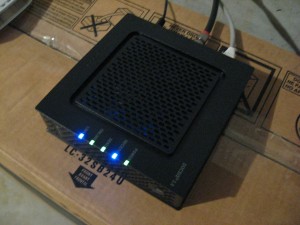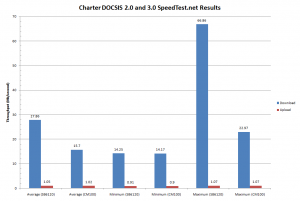I subscribe to one of the cheapest broadband options in the area, Charter’s “Express” cable service, which is advertised as an 8Mb downstream / 1Mb upstream service on a DOCSIS 2.0 cable network. Believing Charter’s DOCSIS 2.0 claim, I plugged in a cheap Linksys CM100 cable modem when we first signed up. After observing nearly double the advertised download speeds, I started to wonder if Charter’s sales representatives were mistaken. We’re in a brand new neighborhood just 20 miles east of St. Louis. Why wouldn’t they have hooked up fancy new DOCSIS 3.0 lines?
Google searches revealed nothing definite. Some folks claimed that upgrading to a DOCSIS 3.0 modem brought much greater performance, even on DOCSIS 2.0 lines. Some claimed no changes at all. I still wasn’t sure whether my area supported DOCSIS 3.0 or not, and further, I assumed that those who saw major benefits were subscribers of top-tier, 25Mb+ services. Then I read about Powerboost®, which is apparently the reason I see download speeds above 8Mb/sec. So, if I was right about my cable line, channel bonding might further improve performance.
Motorola’s SB6120, a DOCSIS 3.0 modem, was on sale at Best Buy last week. I had to pick one up to satisfy my nerdy curiosity.
The SB6120 makes things simple: Blue status LEDs = channel bonding (DOCSIS 3.0); Green LEDs = no channel bonding (not DOCSIS 3.0). Sure enough, the SB6120 booted up with a blue “Receive” LED. Logging into the status page (http://192.168.100.1) confirmed 4 bonded channels.
Charter automatically directed me to http://install.charter.com to verify the MAC address and account number. Within a few minutes, it was ready to go.
Benchmarks
All tests were made from a PC running Windows 7 Pro 64-bit, Firefox 3.6.2, with a gigabit LAN connection.
The real question was, had I wasted $85 to put another blue LED in my basement? Let’s see:
Unfortunately, I discovered that bandwidth varied greatly depending on the test server (although always better than DOCSIS 2.0). This is something I hadn’t noticed before. Below is a SpeedTest.net log of test results with the Motorola SB6120. Benchmarks with asterisks (*) were taken while streaming a Netflix movie on another PC.
The chart below plots the average/min/max upload and download figures from the above tables. Latencies were averaged only for St. Louis, MO test results since benchmarks were not made on identical servers for both modems. The SB6120 improved latency by 0.55ms (negligible).
On average, DOCSIS 3.0 boosted download speeds on the local St. Louis test server by 1.74Mb/second (+11%), with 0.55ms less latency (3% improvement). Taking other servers into consideration, the benefits of DOCSIS 3.0 are extremely obvious. Average download speed increased by 12.16Mb/second (+77%), and maximum throughput increased by 43.89Mb/second (+291%).
Summary
I must admit that I see no difference in browsing speed between DOCSIS 2.0 and DOCSIS 3.0. File downloads are obviously faster and make the modem upgrade well worth the cost.
If you’re in the market for a new cable modem, you might as well spend a bit more for the higher performance of a DOCSIS 3.0 modem. The performance gains are probably even greater for those subscribed to faster cable plans–I’ve barely put the SB6120 to work. With faster service, it’s capable of much more.
Via Jseaber Blog














0 comments:
Post a Comment